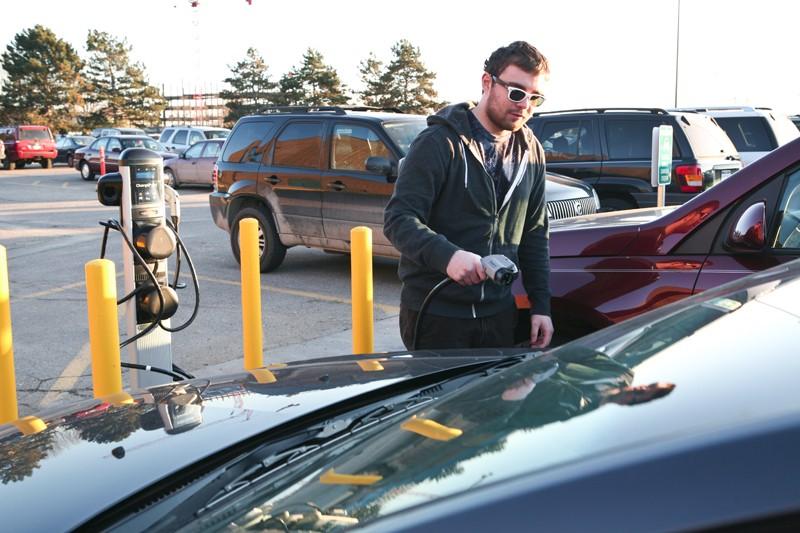Practicality of charging stations questioned

GVL / Eric Coulter Getting Juiced: GVSU student Jacob Campbell plugs in his car before he heads to class
Feb 9, 2012
The seven electric vehicle-charging stations across the Grand Valley State University system are just getting broken in but their usefulness is already coming into question. The chargers have yet to attract a noticeable stream of customers save for the university’s Chevrolet Volt plug-in hybrid. “I am not aware of anyone using the chargers regularly other than the engineering department using it for their Chevy Volt,” said Tim Thimmesch, assistant vice president of Facilities Services.
GVSU does not have data yet on the usage of the chargers but is capable of tracking such statistics through a company called Chargepoint, which monitors charging stations nationwide, said Dave Feenstra, maintenance supervisor for Facilities Services.
“We should look at getting monthly reports from them,” Feenstra said.
Chargepoint mainly deals with stations that charge a fee for electricity, but also keeps data for free stations like those at GVSU.
The charging stations at the Allendale and Pew campuses were funded through grants from the U.S. Department of Energy. Feenstra said the university paid for the installation of the station, which cost $15,000.
John McElroy, an automotive analyst at www.autoline.tv, a Detroit-based website that covers automotive industry news and issues said having charging infrastruction does not make sense as “there are just so few EV’s out there.”
“GM and Nissan (makers of the Volt and Nissan Leaf, respectively) sold fewer than 16,000 electric cars,” in a year with 12.8 million total vehicle sales, McElroy said.
Owners of electric vehicles and plug-in hybrids are reluctant to use public charging facilities unless they are incredibly convenient, McElroy said, adding that those motorists would rather charge their cars at home.
According to McElroy, the average household income of an electric car buyer is $170,000, meaning that investments in infrastructure for such vehicles would disproportionately benefit the wealthiest members of the university community. Electric and plug-in hybrid vehicle sales will make up one percent of total light vehicle sales by 2025, he said.
Currently, efficient diesel cars outsell all hybrid and electric vehicles, McElroy said, even without incentives and with only being sold by German automakers.
Bart Bartels, GVSU’s campus sustainability manager, said the university’s seven charging stations were not installed to satisfy the needs of vehicles on the road and in campus parking lots today, but rather to meet the demands of vehicles that have not been made yet.
“Ford and GM are looking at much higher EV sales figures for 2012,” he said. “In state EV sales projections are 1,384 for 2012, 2,084 in 2013 and another 2,444 in 2014.”
Bartels said the people of Michigan pay $1 billion annually to buy fossil fuels from out of state. “Electric vehicles are a way to support the local economy by keeping our money in state,” he said. “For Grand Valley, providing charging stations allows our community to utilize these types of vehicles, and enables them to reduce their carbon footprint, helping insure a sustainable future for us all.”






















